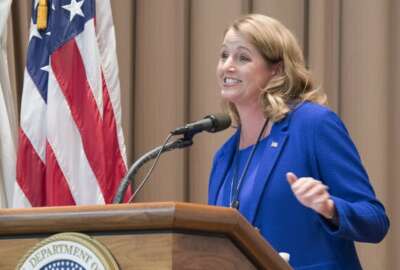SBA wraps up CDM pilot as part of enterprise IT transformation
SBA has leveraged data analytics tools to build out a cybersecurity dashboard that provides an around-the-clock look at every agency device that’s connected to...
Whether it’s helping small businesses recover from natural disasters or just getting the word out about its services, the Small Business Administration deploys its personnel all across the country.
In order to give its employees in the field access to the data they need, SBA has led the charge on cloud migration. Now the agency has wrapped up a continuous diagnostics and mitigation (CDM) pilot with the Department of Homeland Security to better secure its data.
Through the pilot, SBA has leveraged data analytics tools to build out a cybersecurity dashboard that provides an around-the-clock look at every agency device that’s connected to its network, all the way down to mobile devices.
SBA’s cloud-first approach to cybersecurity not only ensure that its desktops and servers get the latest software updates. Maria Roat, SBA’s chief information officer, said cloud-native tools have allowed the agency to stay “predictive” about activity on its network.
“If somebody goes on foreign travel and we don’t know about it, we can see people logging in from other countries, getting ahead of what’s going on in the environment,” Roat said in an interview with Federal News Network. “Whether it’s what threats might be against SBA … being able to see our entire inventory, who’s on our network, what they’re doing, how they’re using our networks, and having visibility into that environment – that’s something we did not have before.”
SBA stands out as a leader in cloud migration, having advanced through all four phases of CDM.
But in terms of goals, Roat said her agency sees potential in using its cloud architecture to provide a “360-degree view” of its customers. That, combined with artificial intelligence or machine learning tools, could help the SBA anticipate the needs of more than 30 million small-business owners.
“If somebody gets a loan, and then they’re looking at business plans, I can start using AI, if I have that customer model, to be predictive [and say] ‘Oh, by the way, customer, here’s what you might need next,’” she said.
In order to reach that 360-view of the customer, the agency has set into motion an enterprise IT transformation strategy that has laid as its foundation an overhaul of network identity access, employee productivity tools, data access and support services.
“Enterprise transformation, there’s multiple pieces and parts to it, because it’s not just about putting one tool in place. It’s looking at the entire ecosystem of technology, as well as the people and processes to really drive that digital transformation that we are in the midst of,” Roat said.
This year, SBA has taken steps to implement an IT workforce strategy it completed in May 2018. Roat said the strategy includes teaching the workforce the basic of cloud, as well as data analytics and employee collaboration tools.
“As you spin up [virtual machines] in the environment, people need to understand how to operate in that environment,” she said. “It’s very different from being on-prem and having hardware that you’re working on.”
Through this IT transformation plan, Roat and her team have collaborated with SBA’s chief data officer to develop an agency data lake for analytics and stood up a data community of practice.
“Certainly, my office and the relationship with the CDO is a partnership, and so we’re working very closely together because I’ve got all these elements that I’ve put in place already, even before the advent of the law,” Roat said.
The Foundations for Evidence-Based Policymaking Act, which President Donald Trump signed in January, mandated all agencies had until the end of July to appoint chief data officers and chief evaluation officers.
Other policy changes include an executive order President Donald Trump signed in May 2018 giving agency CIOs direct hiring authority to fill critical skill gaps.
But before CIOs could take advantage of that new authority, the Office of Personnel Management had to send the proposed rule out for public comment.
“I am just now getting started on my vacancies to use that hiring authority,” Roat said. “I’ve got a couple in the pipeline right now.”
In the most recent Federal Information Technology Acquisition Reform Act (FITARA) scorecard, SBA stood out as one of just a few agencies that received an ‘A’ for their implementation of the Modernizing Government Technology Act.
Part of that, Roat said, comes down to her office and SBA’s chief financial officer working closely with the Office of Management and Budget, as well as the agency’s Office of Legislative Affairs to set up a working capital fund.
“Given where we are on the modernization trajectory, being able to do longer-term planning, instead of doing 12-month sprints … having the ability to look longer-term over three years by turning that one-year money into three-year money, gives me a little bit more flexibility,” she said.
Some agencies have faced an uphill battle with implementing the working capital funds, since they require a reprogramming of funds. While SBA remains in the middle of that reprogramming effort, Roat said the agency has identified several long-term projects to fund.
One major project is to consolidate all of the agency’s IT service desks onto one platform. That’s a major task because some service desks, Roat explained, only deal with problems with specific applications in certain program offices and have their own tracking management systems.
“I need to assess all of those service desks that are across the agency for those program-specific things and understand what they’re doing, how they’re responding, and then bring it onto an enterprise platform for an IT service, so that we’re all using the same platform,” Roat said. “That’s going to take time because I’ve got to get the assessment done. I’m not one to eat the whole elephant at once, so I’m going to take small bites out of it and then start migrating those other service desks onto the platform.”
Copyright © 2025 Federal News Network. All rights reserved. This website is not intended for users located within the European Economic Area.
Jory Heckman is a reporter at Federal News Network covering U.S. Postal Service, IRS, big data and technology issues.
Follow @jheckmanWFED
Related Stories





